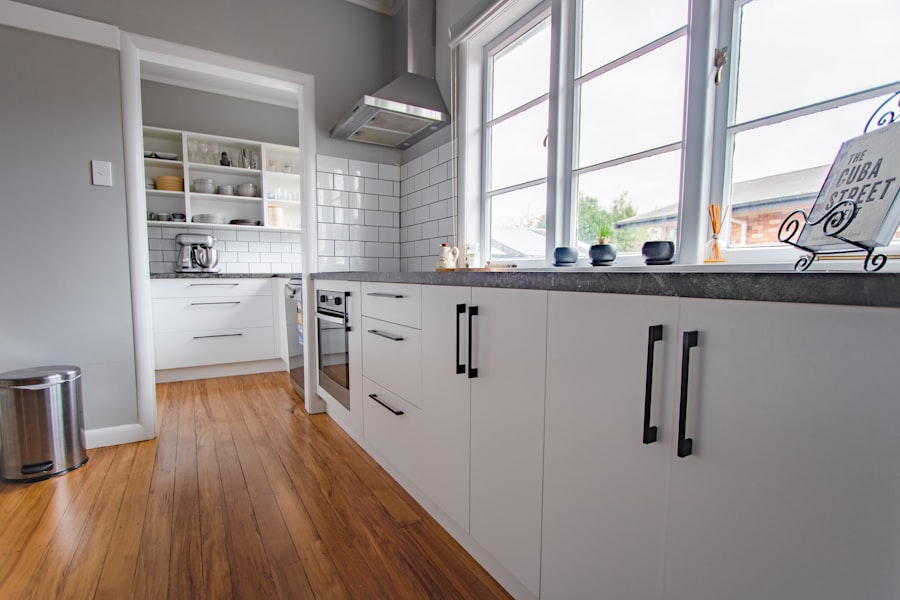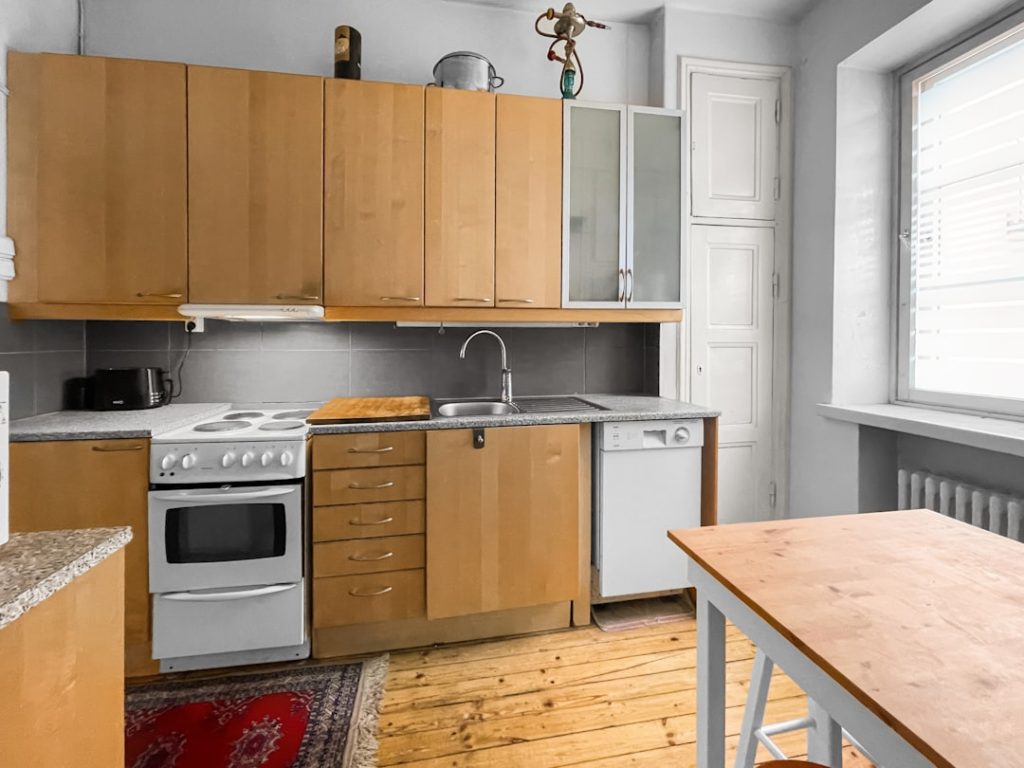Establishing a budget is a critical first step in any kitchen renovation project. The kitchen is often considered the heart of the home, and its renovation can significantly enhance both functionality and aesthetics. However, without a clear understanding of the costs involved, homeowners may find themselves overwhelmed or financially strained.
A well-defined budget not only helps in managing expenses but also sets realistic expectations for the scope of the project. It is essential to consider both the initial costs and potential long-term investments that can arise from a kitchen remodel. When setting a budget, homeowners should begin by researching average costs associated with kitchen renovations in their area.
This includes understanding the price ranges for materials, labor, and design services. For instance, a minor kitchen remodel might cost between $10,000 to $15,000, while a major overhaul could easily exceed $50,000. Additionally, it is wise to allocate a contingency fund—typically around 10-20% of the total budget—to cover unexpected expenses that may arise during the renovation process.
This proactive approach can prevent financial strain and ensure that the project remains on track.
Key Takeaways
- Setting a budget is crucial for understanding the costs of kitchen renovation and avoiding overspending.
- Factors such as the size of the kitchen, quality of materials, and labor costs can significantly affect the overall cost of renovation.
- Estimating the cost of materials and labor is essential for creating a realistic budget and avoiding unexpected expenses.
- Hidden costs such as permits, disposal fees, and structural repairs should be considered when budgeting for kitchen renovation.
- Budget-friendly alternatives like refacing cabinets, painting, and using affordable materials can help reduce the overall cost of renovation.
- Comparing the cost of hiring professionals versus DIY can help determine the most cost-effective approach for kitchen renovation.
- Exploring financing options such as personal loans, home equity loans, or credit cards can help cover the cost of kitchen renovation.
- Tips for managing costs during kitchen renovation include prioritizing needs, getting multiple quotes, and being flexible with the design to stay within budget.
Factors Affecting the Cost of Kitchen Renovation
Several factors can influence the overall cost of a kitchen renovation, and understanding these elements is crucial for effective budgeting. One of the primary factors is the size of the kitchen. Larger kitchens generally require more materials and labor, which can significantly increase costs.
Additionally, the complexity of the design plays a vital role; intricate layouts or custom cabinetry can drive up expenses compared to simpler designs. Homeowners should also consider the existing layout and whether structural changes are necessary, as moving plumbing or electrical systems can add substantial costs. Another important factor is the choice of materials.
High-end finishes such as granite countertops or custom cabinetry can elevate the aesthetic appeal but come with a higher price tag. Conversely, opting for more affordable materials like laminate or stock cabinets can help keep costs down without sacrificing style. The appliances selected for the kitchen also contribute to the overall budget; energy-efficient models may have a higher upfront cost but can lead to savings in utility bills over time.
Understanding these factors allows homeowners to make informed decisions that align with their budgetary constraints while still achieving their desired kitchen look.
Estimating the Cost of Materials and Labor

Accurate estimation of materials and labor costs is essential for any kitchen renovation project. Homeowners should begin by creating a detailed list of all necessary materials, including cabinets, countertops, flooring, appliances, and fixtures. Each item should be researched for pricing, taking into account both quality and durability.
For example, while solid wood cabinets may be more expensive upfront, they often provide better longevity compared to cheaper alternatives like particleboard. Labor costs can vary significantly based on location and the complexity of the work involved. Hiring skilled professionals such as contractors, electricians, and plumbers typically incurs higher costs than opting for less experienced laborers.
It is advisable to obtain multiple quotes from different contractors to ensure competitive pricing. Additionally, homeowners should consider whether they will need specialized services for tasks such as tiling or custom cabinetry installation, as these can further impact labor costs. By thoroughly estimating both material and labor expenses, homeowners can create a more accurate budget that reflects the true cost of their kitchen renovation.
Hidden Costs to Consider in Kitchen Renovation
| Hidden Costs to Consider in Kitchen Renovation |
|---|
| 1. Structural Changes |
| 2. Permit and Inspection Fees |
| 3. Electrical and Plumbing Upgrades |
| 4. Unexpected Repairs |
| 5. Customization and Design Changes |
| 6. Additional Labor Costs |
| 7. Material Overages |
| 8. Temporary Kitchen Setup |
While many homeowners focus on visible expenses when planning a kitchen renovation, hidden costs can often catch them off guard. One common hidden cost is related to permits and inspections. Depending on local regulations, certain renovations may require permits that come with associated fees.
Failing to account for these costs can lead to unexpected financial burdens down the line. Additionally, if structural changes are made, inspections may be necessary to ensure compliance with building codes. Another hidden cost to consider is the potential need for repairs or upgrades to existing systems.
For instance, if plumbing or electrical systems are outdated or not up to code, they may need to be replaced or upgraded during the renovation process. This can add significant expenses that were not initially anticipated. Furthermore, homeowners should be aware of potential delays in the renovation timeline due to unforeseen issues, which can lead to additional labor costs if workers are on-site longer than planned.
By anticipating these hidden costs, homeowners can better prepare themselves financially and avoid surprises during their renovation journey.
Budget-Friendly Alternatives for Kitchen Renovation
For homeowners looking to renovate their kitchens without breaking the bank, there are several budget-friendly alternatives that can achieve impressive results. One effective strategy is to focus on cosmetic updates rather than complete overhauls. For example, repainting cabinets instead of replacing them can refresh the space at a fraction of the cost.
Additionally, updating hardware such as knobs and pulls can provide a modern touch without significant investment. Another cost-effective approach is to consider open shelving instead of traditional upper cabinets. Open shelving not only creates an airy feel but also allows homeowners to display decorative items or frequently used dishes.
This option can save money on cabinetry while adding character to the kitchen. Furthermore, investing in energy-efficient appliances during a renovation can lead to long-term savings on utility bills, making them a wise choice for budget-conscious homeowners. By exploring these alternatives, individuals can achieve a stylish kitchen transformation while staying within their financial limits.
When it comes to kitchen renovations, homeowners often face the decision of whether to hire professionals or tackle the project themselves (DIY). Each option has its own set of advantages and disadvantages that can significantly impact overall costs. Hiring professionals typically ensures high-quality workmanship and adherence to building codes; however, it also comes with higher labor costs.
For instance, hiring a licensed contractor may cost between $50 to $150 per hour depending on their expertise and location. On the other hand, DIY projects can save money on labor costs but require a significant investment of time and effort from homeowners. Individuals must possess a certain level of skill and knowledge to successfully complete tasks such as plumbing or electrical work; otherwise, they risk costly mistakes that could necessitate hiring professionals later on.
Additionally, while DIY projects may seem more affordable initially, they can lead to hidden costs if tools or materials need to be purchased or if mistakes require professional correction. Ultimately, homeowners must weigh their skills, available time, and budget constraints when deciding between hiring professionals or taking on DIY renovations.
Financing Options for Kitchen Renovation

For many homeowners, financing options play a crucial role in making kitchen renovations feasible within their budgets. Traditional home equity loans allow individuals to borrow against the equity they have built in their homes; this option often comes with lower interest rates compared to personal loans or credit cards. Home equity lines of credit (HELOCs) are another popular choice that provides flexibility in borrowing as needed throughout the renovation process.
Additionally, some homeowners may consider personal loans specifically designed for home improvement projects. These loans typically have fixed interest rates and repayment terms that make them manageable over time. Government-backed programs such as FHA 203(k) loans also offer financing options for those looking to purchase or refinance homes while including renovation costs in their mortgage.
By exploring various financing avenues, homeowners can find solutions that align with their financial situations and enable them to achieve their dream kitchens.
Tips for Managing Costs During Kitchen Renovation
Managing costs effectively during a kitchen renovation requires careful planning and strategic decision-making throughout the process. One key tip is to prioritize essential upgrades over cosmetic changes; focusing on functionality first ensures that critical aspects of the kitchen are addressed within budget constraints. For example, investing in new appliances or improving storage solutions may take precedence over aesthetic enhancements like new countertops.
Another effective strategy is to shop around for materials and appliances before making purchases. Many retailers offer seasonal sales or discounts that can lead to significant savings on high-ticket items like cabinets or countertops. Additionally, considering alternative suppliers such as local wholesalers or online marketplaces can yield better prices compared to traditional home improvement stores.
Homeowners should also remain flexible with their design choices; being open to slightly different styles or materials can lead to unexpected savings without compromising overall quality. By implementing these tips and maintaining an organized approach throughout the renovation process, homeowners can effectively manage costs while achieving their desired kitchen transformations.



